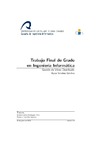Identificador persistente para citar o vincular este elemento:
https://accedacris.ulpgc.es/jspui/handle/10553/10284
| Campo DC | Valor | idioma |
|---|---|---|
| dc.contributor.advisor | Domínguez Brito, Antonio Carlos | - |
| dc.contributor.advisor | Castrillón Santana, Modesto Fernando | - |
| dc.contributor.author | Sánchez Sánchez, Bycor | - |
| dc.date.accessioned | 2013-06-21T12:44:01Z | - |
| dc.date.accessioned | 2018-06-04T11:44:28Z | - |
| dc.date.available | 2013-06-21T12:44:01Z | - |
| dc.date.available | 2018-06-04T11:44:28Z | - |
| dc.date.issued | 2013 | en_US |
| dc.identifier.uri | https://accedacris.ulpgc.es/handle/10553/10284 | - |
| dc.description.abstract | El principal objetivo de este Trabajo Final de Grado (TFG) fue la creación de un sistema de gestión de vídeo distribuido utilizando cámaras de videovigilancia IP. Esta propuesta surgió a partir de la idea de ofrecer un acceso simultáneo, tanto online como offline, a las secuencias de vídeo generadas por una red de cámaras IP en un entorno dado. El resultado obtenido fue una infraestructura software ampliable que ofrece al usuario una serie de funcionalidades con cámaras de red, abstrayéndolo de detalles internos. El trabajo está compuesto por tres elementos claramente diferenciados: integración de cámaras IP, almacenamiento en vídeo y creación del sistema de vídeo distribuido. La integración de cámaras IP tiene como objetivo comunicar al equipo con la cámara de red para la obtención del flujo de imágenes que transmite. Dicha comunicación se establece vía HTTP (Hypertext Transfer Protocol) gracias a la interfaz de programación (API) de la que disponen estos dispositivos. El segundo elemento, el almacenamiento en vídeo, tiene como función guardar las imágenes de la cámara IP en archivos de vídeo. De esta manera se ofrece su posterior visualización en diferido. Finalmente, el sistema de vídeo distribuido permite la reproducción simultánea de múltiples vídeos grabados por la red de cámaras IP. Adicionalmente, vídeos grabados por otros dispositivos también son admitidos. El material desarrollado dispone del potencial necesario para convertirse en una herramienta libre de amplio uso en sistemas UNIX para cámaras IP, así como suponer la base de futuros proyectos relacionados con estos dispositivos. | en_US |
| dc.description.abstract | The main objective of this Trabajo Final de Grado (TFG) was the creation of a distributed video management system using surveillance IP cameras. This proposal arises from the idea of offering simultaneous access, online and offline, to video sequences generated by an IP camera network in a giving environment. As a result, we obtained an upgradeable software infrastructure which provides the user with several functionalities with network cameras, abstracting him from internal details. The work can be clearly divided into three different parts: IP camera integration, video storage and distributed video system. The aim of IP camera integration is to allow the communication between the computer and a network camera to obtain its image stream. That communication is established via HTTP (Hypertext Transfer Protocol) thanks to the Application Programming Interface (API) of these devices. The video storage main function is to save the IP camera image streams into video files. In this way recorded video sequences can be watched anytime. Finally, the distributed video system allows the user to play multiple videos recorded simultaneously by the IP camera network. Additionally, videos recorded by other devices are accepted as well. The material developed has the potential to be a free tool widely used on UNIX systems for IP cameras, as well as become the base of future projects associated with these devices. | en_US |
| dc.language | spa | en_US |
| dc.subject | 120317 Informática | en_US |
| dc.subject.other | Cámaras IP | en_US |
| dc.subject.other | Network cameras | en_US |
| dc.title | Gestión de vídeo distribuido | en_US |
| dc.type | info:eu-repo/semantics/bachelorThesis | en_US |
| dc.type | BachelorThesis | en_US |
| dc.compliance.driver | 1 | es |
| dc.contributor.departamento | Informática y Sistemas | en_US |
| dc.contributor.facultad | Escuela de Ingeniería Informática | en_US |
| dc.identifier.absysnet | 682629 | - |
| dc.investigacion | Ingeniería y Arquitectura | en_US |
| dc.rights.accessrights | info:eu-repo/semantics/openAccess | es |
| dc.type2 | Trabajo final de grado | en_US |
| dc.utils.revision | Sí | en_US |
| dc.identifier.matricula | TFT-26135 | es |
| dc.identifier.ulpgc | Sí | en_US |
| dc.contributor.buulpgc | BU-INF | en_US |
| dc.contributor.titulacion | Grado en Ingeniería Informática | es |
| item.fulltext | Con texto completo | - |
| item.grantfulltext | open | - |
| crisitem.advisor.dept | GIR SIANI: Inteligencia Artificial, Robótica y Oceanografía Computacional | - |
| crisitem.advisor.dept | IU Sistemas Inteligentes y Aplicaciones Numéricas | - |
| crisitem.advisor.dept | Departamento de Informática y Sistemas | - |
| crisitem.advisor.dept | GIR SIANI: Inteligencia Artificial, Robótica y Oceanografía Computacional | - |
| crisitem.advisor.dept | IU Sistemas Inteligentes y Aplicaciones Numéricas | - |
| crisitem.advisor.dept | Departamento de Informática y Sistemas | - |
| Colección: | Trabajo final de grado | |
Visitas
232
actualizado el 17-may-2025
Descargas
206
actualizado el 17-may-2025
Google ScholarTM
Verifica
Comparte
Exporta metadatos
Este elemento está sujeto a una licencia Licencia Creative Commons

